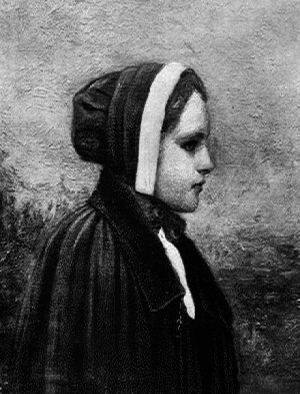Bridget Bishop facts for kids
Quick facts for kids
Bridget Bishop
|
|
|---|---|

Bishop, as depicted in a lithograph
|
|
| Born |
Bridget Magnus
c. 1632 |
| Died | 10 June 1692 (aged c. 60) |
| Cause of death | Died during the trials |
| Other names | Goody Oliver, Goody Bishop |
| Criminal charge(s) | Accused of Witchcraft (later cleared) |
| Criminal penalty | Sentenced to death |
| Criminal status | Died (10 June 1692) Exonerated (31 October 2001) |
Bridget Bishop (born around 1632 – died 10 June 1692) was the first person to die during the Salem witch trials in 1692. She was accused of witchcraft. During this time, about 200 people faced similar accusations.
Contents
Her Life and Family
Bridget's original family name was Magnus. Later, her family adopted the name Playfer. This was her paternal grandmother's maiden name. Bridget was married three times.
Her first husband was Captain Samuel Wesselby. They married on April 13, 1660, in Norwich, England. Bridget had two sons, John and Benjamin, and one daughter, Mary, from this marriage. Her first husband passed away in 1666.
Her second marriage was to Thomas Oliver on July 26, 1666. He was a well-known businessman. They had one daughter named Chrestian. Bridget had been accused of causing Thomas Oliver's death earlier, but she was found not guilty.
Around 1687, she married her third husband, Edward Bishop. He was a successful sawyer, someone who cuts wood. Edward Bishop was also one of the people who helped start the First Church of Beverly.
Bridget and Edward ran two taverns together. People often saw Bridget wearing colorful and unusual clothes. These clothes were different from what most people wore back then.
The Accusations Against Her
Bridget Bishop was questioned because people suspected her of "many acts of witchcraft." On April 19, 1692, she was accused of harming five young women. These women were Abigail Williams, Ann Putnam, Jr., Mercy Lewis, Mary Walcott, and Elizabeth Hubbard.
Her trial lasted for eight days. It is often seen as the official start of the Salem Witchcraft Trials. A writer named Cotton Mather wrote about her trial in his book, "Wonders of the Invisible World."
What People Said
Mather wrote that several people spoke against Bridget Bishop. They claimed that her ghostly shape would pinch, choke, or bite them. He also said that if Bishop looked at one of her accusers, they would immediately fall down. Only her touch could make them feel better again.
More claims were made during the trial. One woman said that Bishop's ghost tore her coat. When her coat was checked, it was torn in the exact spot she described. Mather noted that these many accusations seemed very suspicious.
Ezekiel Cheevers and John Putnam were the ones who first complained about Bridget Bishop. They accused her of using witchcraft on the five women mentioned earlier. These women said that Bridget Bishop was the witch who hurt them.
Ann Putnam claimed that Bishop called the devil her God. Other people, like Richard Coman, accused Bishop of grabbing their throats. He also said she pulled him and his wife out of bed. Other girls claimed she harmed them with just a quick look. Even Bishop's own husband said she praised the devil.
William Stacy, a man from Salem Town, said that Bishop had told him others thought she was a witch. He confronted her, saying she was using witchcraft to bother him. She denied it. Another local man, Samuel Shattuck, accused Bishop of harming his child. He also claimed she hit his son with a spade.
Shattuck also said Bishop asked him to dye some lace. He thought the lace was too small for anything but a "poppet." A poppet is a small doll sometimes used in spell-casting. John and William Bly, a father and son, testified about finding poppets in Bishop's house. They also spoke about their cat, which seemed sick or poisoned after an argument with Bishop.
Other people Mather mentioned as victims included Deliverance Hobbs, John Cook, Samuel Gray, and John Louder.
The Outcome of the Trial
In the end, Mather stated that Bridget Bishop was mainly condemned because she seemed to lie a lot in court. According to Mather, "there was little occasion to prove the witchcraft, it being evident and notorious to all beholders."
Bridget Bishop was sentenced to death. She died on June 10, 1692.
Images for kids


